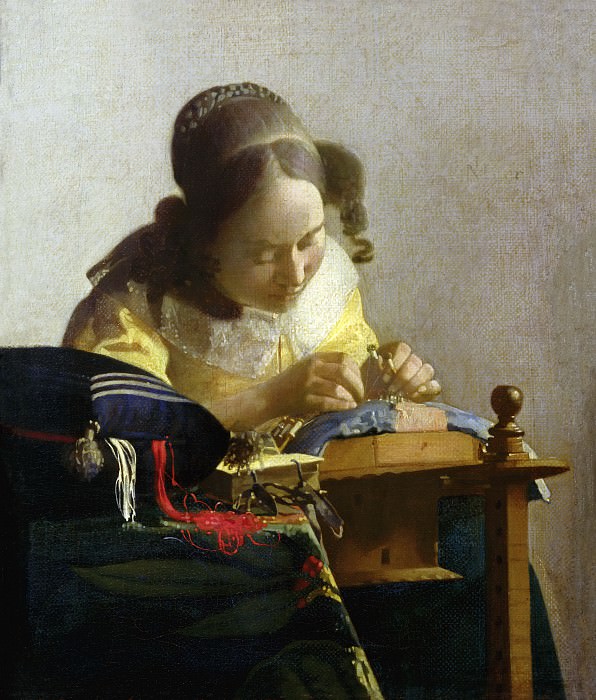The Lacemaker Johannes Vermeer (1632-1675)
Johannes Vermeer – The Lacemaker
Edit attribution
Image taken from other album: gallerix.org/s/991555443/N/2920050127/
Download full size: 3500×4116 px (4,1 Mb)
Painter: Johannes Vermeer
Location: Louvre (Musée du Louvre), Paris.
"The Lacewoman" is a typical Baroque-era canvas in Dutch painting. Certain subjects, the features and proportions of the characters’ bodies, and the colors are all hallmarks of Dutch painting. The canvas depicts a young girl. She is concentrating on her craft - she is knitting lace, delicate and exquisite. The canvas depicts the girl’s work from a close distance. You can’t look at the whole picture at once, the view moves constantly, lingering alternately on one and another detail.
Description of Jan Vermeer’s painting The Lacemaker
"The Lacewoman" is a typical Baroque-era canvas in Dutch painting. Certain subjects, the features and proportions of the characters’ bodies, and the colors are all hallmarks of Dutch painting.
The canvas depicts a young girl. She is concentrating on her craft - she is knitting lace, delicate and exquisite. The canvas depicts the girl’s work from a close distance. You can’t look at the whole picture at once, the view moves constantly, lingering alternately on one and another detail. In order to focus the author of the painting uses an interesting move - the closer objects are painted blurred. Nevertheless, it is easy to distinguish the needle-pad, as well as several threads of different colors hanging from it. The cushion is a very important item for any lacemaker - with its help the lace was weaved, as the cushion was a kind of prop.
On the table there is a thick tapestry tablecloth with an interesting pattern. It is difficult to make out, but it is noticeable that it is bright and exquisite. This fabric was obviously brought from distant countries. The girl herself weaves the lace on a special table, in fact, it is a machine for spinning lace. It could be adjusted, changing its position.
The room is modestly decorated - white walls, traditionally whitewashed walls for the Renaissance.
Near the lace you can notice a book. You can see that it is upholstered with expensive cloth - so the book is probably a church book. Of course, special girls became lacemakers, it was a craft for the best young ladies, as only the select few were allowed such fine work.
The girl is pale. Her head is adorned with her hair neatly arranged in a hairdo. It is impossible to see the girl’s face as she is bent over her work.
Кому понравилось
Пожалуйста, подождите
На эту операцию может потребоваться несколько секунд.
Информация появится в новом окне,
если открытие новых окон не запрещено в настройках вашего браузера.
You need to login
Для работы с коллекциями – пожалуйста, войдите в аккаунт (open in new window).








![Johannes Vermeer - Girl with the Red Hat [attr.]](http://cdn.gallerix.asia/j/V/306549019/876244957.webp)











COMMENTS: 5 Ответы
А кто такой Вермер? Где тут живопись?
Это я вам как член заявляю!
Копилов Олександр Генадійович
Член національної Спілки художників України (живопис, графіка) посвідчення №6203
Ты идиот или как?
Одна из любимых картин С. Дали. Гении правят миром!
Ха, искусственный интелект (в квадрате!) не знает, что такое коклюшки, но стремится креативить. Куда цивилизация катится?
интелЛект, пардон
You cannot comment Why?
The painting The Lacemaker depicts a young woman intently focused on her intricate work. She is shown from the chest up, her head bowed in concentration as her hands meticulously manipulate threads and bobbins. Her hair is pulled back loosely, and she wears a modest, yellowish gown with a white collar. The background is softly lit and indistinct, emphasizing the subject of her labor. On the left side of the frame, a bundle of blue and red fabric is draped, hinting at the materials involved in her craft.
The subtexts of this painting are rich and multifaceted. Primarily, it is a celebration of domestic skill and quiet industry. The detailed rendering of the lacemaking process highlights the patience, precision, and talent required for such a craft, elevating it to an art form. The young womans absorbed posture and focused gaze convey a sense of dedication and absorption in her task, suggesting the importance of mindful work and self-sufficiency.
Furthermore, the intimate scale of the painting and the soft lighting create a sense of quiet contemplation and solitude. While she is engaged in a task that is often communal, she appears deeply immersed in her own world, which can be interpreted as a portrayal of inner peace or focused self-development. The painting also subtly speaks to the economic role of women in the 17th century, where skills like lacemaking provided both a means of personal adornment and a source of income.
Finally, in the context of Vermeers oeuvre, the painting can be seen as exploring themes of light, perception, and the beauty found in the ordinary. The way light falls on the womans face and hands, and the subtle textures of the threads and fabric, demonstrate Vermeers mastery in capturing the ephemeral qualities of light and the tangible reality of everyday life. The painting is a testament to the dignity and grace inherent in skilled labor.